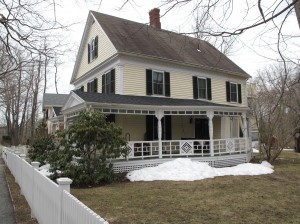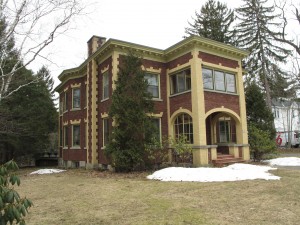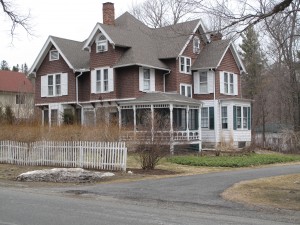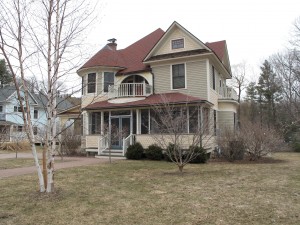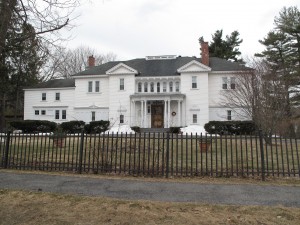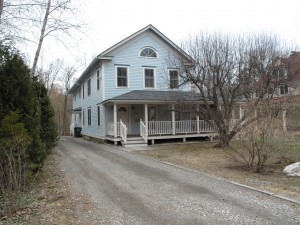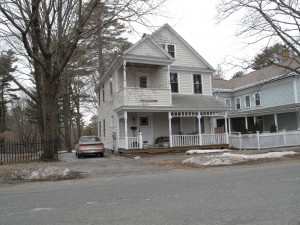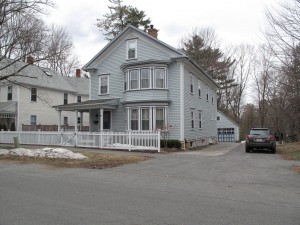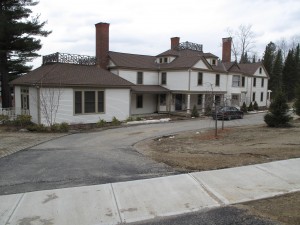
From Surveys Completed 2011-2012 by the Lenox Historical Commission
ARCHITECTURAL DESCRIPTION:
This rambling, 2-story, wood-framed house evolved over quite a number of years and is categorized as Colonial Revival. It incorporates both a hipped and a gable roof with hipped roof dormers on the front, left and rear sides. Two 2-story wings extend from the central section, one from each side. The main section of the house is topped by a metal balustrade, as is a lower 1-story addition off the left side ell. It has three tall brick chimneys. The cladding is wood clapboard and it has wood corner boards, cornices, and trim. A porch is created by a recessed entry with the second floor over it supported by three chamfered pillars atop collared and paneled plinths. A secondary entrance to the right of the front entrance is also recessed with a smaller overhang supported by a single pillar matching those for the main porch. These porches are separated by a 2-story bow window topped by a projecting pedimented front gable roof. The earliest portions of the house have stone foundations. There is a 2-story, cross-gabled rear ell, with bow window on its rear facade. A 2-story, 2-bay-wide, front-gabled pavilion (projecting to both front and rear) to the right side was also added. Both additions appear to have been constructed sometime after 1939. There is a large circular driveway in front of the house, accessed from one point on Kemble Street, with adjoining parking area. The house is at a lower grade from the street necessitating a large retaining wall in the right front corner of the lot (recently constructed). Newly planted young coniferous trees have been planted between the driveway/retaining wall and the street. There are other mature coniferous and deciduous trees on the property.
NOTE: The 1905 Sanborn Map labels this property “Mrs. F. L. Sturgis” and “Clipston Grange.” The 1911 and 1939 Sanborn Maps depict the same building footprint as the 1905 map. The architect is still unknown.
HISTORICAL NARRATIVE:
This once festive Lenox country house of New Yorkers, Florence Lydig and Franklin K. Sturgis, had almost been forgotten before its rescue and restoration in 2007 by the Jurney family in conjunction with their plan for Spring Lawn. The panel core of this fascinating structure is an old village house, which originally stood at the junction of Main and Cliffwood Streets. George G. Haven, a New York Stockbroker and a Lenox real estate speculator moved the old house to its present location in c.1893.
Frank and Florence Sturgis enlarged the house in 1894 in the Colonial Revival style adorning the roofline with a parapet, installing elegant bow windows in the dining room and study and adding a new reception room at the south end. A childless couple, the Sturgises were devoted to animals. Florence’s family property is now the Bronx Zoo and Frank was a founder of the Society for the Prevention of Cruelty to Animals. The epitome of this dapper gentleman, businessman and sportsman, Frank served a term as President of the New York Stock Exchange, on the building committee of Madison Square Garden, on the boards of the Jockey Club and the New York Coaching Club.
Four years after Mrs. Sturgis died in 1922, Mr. Sturgis left Clipston Grange to the new and growing Lenox School for Boys which was at that time based in Sunnycroft which was next door.
BIBLIOGRAPHY and/or REFERENCES:
1905, 1911 and 1939 Sanborn Maps
2008 House Tour Brochure by Cornelia B. Gilder
Lenox Assessor’s database
